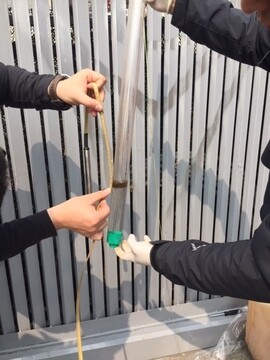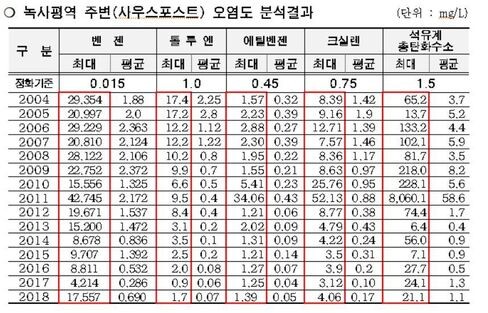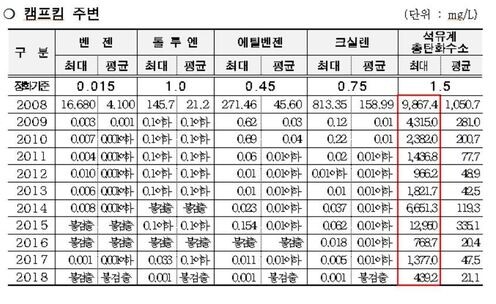hankyoreh
Links to other country sites 다른 나라 사이트 링크
Groundwater near US Yongsan Garrison found to contain excessive carcinogen levels

Tests of groundwater near the US military base in Seoul’s Yongsan District found that the levels of benzene, a serious carcinogen, were 1,170 times higher than official safety standards.
Pollution testing at 62 observation wells used to measure groundwater near the Yongsan Garrison found that groundwater pollution exceeded safety standards at 27 of the observation wells, the city of Seoul announced on Dec. 21. Twenty-one of the observation wells are near Camp Kim, and 41 are near Noksapyeong Station in Yongsan District. The city, which monitors water quality in civilian groundwater and subway leakage at 45 points outside the bases, added that there were no indications that oil pollution had spread.
According to the data released by the city on Friday, benzene, a group-1 carcinogen, was detected in 16 of 41 observation wells near Noksapyeong Station, with levels as high as 1,170 times (17.557mg/L) the standard (0.015mg/L) mandated by South Korea’s Groundwater Act. While this was a 40% decline from 2004, when observation began (29.354mg/L, 1,956 times the safety standard), it’s still very high.

Benzene is classified as a group 1 carcinogen by the International Agency for Research on Cancer, part of the World Health Organization. The chemical is known to cause leukemia and other cancers of the blood and to also have a negative effect on reproductive function.
At 11 of the 21 groundwater observation wells near Camp Kim, total petroleum hydrocarbons (TPH) were detected as high as 292 times (439.2mg/L) the levels required by the Groundwater Act (1.5mg/L). The presence of TPH in samples indicates pollution caused by kerosene, diesel fuel, jet fuel or bunker C fuel. When observation began in 2008, measurements at the same spot found a TPH level of 9,867.4mg/L, 6,578 times higher than the government standard.
“The measurements of benzene and total petroleum hydrocarbons greatly exceeded the cleanliness standards mandated by the Groundwater Act, and free phase oil was also detected, which means oil leaked in the past is still floating on the surface of the groundwater,” said an official at Seoul’s Water Cycle Policy Division.
After oil pollution was discovered at Noksapyeong Station, near the Yongsan Garrison, in 2001, Seoul dug groundwater observation wells nearby and has been carrying out cleanup work and pollution testing ever since. City analysts believe that oil that was leaked on the base in the past remains there today and is seeping into surrounding areas, including Noksapyeong Station.
Seoul plans to submit recommendations to South Korea’s Ministry of Defense, Ministry of Foreign Affairs and Ministry of Environment to revise South Korea’s Status of Forces Agreement (SOFA) with the US and to carry out an in-depth survey inside the US base prior to its handover to restore water quality to original levels in line with environmental legislation.


By Kim Mi-hyang, staff reporter
Please direct comments or questions to [english@hani.co.kr]

Editorial・opinion
![[Column] Park Geun-hye déjà vu in Yoon Suk-yeol [Column] Park Geun-hye déjà vu in Yoon Suk-yeol](https://flexible.img.hani.co.kr/flexible/normal/500/300/imgdb/original/2024/0424/651713945113788.jpg) [Column] Park Geun-hye déjà vu in Yoon Suk-yeol
[Column] Park Geun-hye déjà vu in Yoon Suk-yeol![[Editorial] New weight of N. Korea’s nuclear threats makes dialogue all the more urgent [Editorial] New weight of N. Korea’s nuclear threats makes dialogue all the more urgent](https://flexible.img.hani.co.kr/flexible/normal/500/300/imgdb/original/2024/0424/7317139454662664.jpg) [Editorial] New weight of N. Korea’s nuclear threats makes dialogue all the more urgent
[Editorial] New weight of N. Korea’s nuclear threats makes dialogue all the more urgent- [Guest essay] The real reason Korea’s new right wants to dub Rhee a founding father
- [Column] ‘Choson’: Is it time we start referring to N. Korea in its own terms?
- [Editorial] Japan’s rewriting of history with Korea has gone too far
- [Column] The president’s questionable capacity for dialogue
- [Column] Are chaebol firms just pizza pies for families to divvy up as they please?
- [Column] Has Korea, too, crossed the Rubicon on China?
- [Correspondent’s column] In Japan’s alliance with US, echoes of its past alliances with UK
- [Editorial] Does Yoon think the Korean public is wrong?
Most viewed articles
- 1[Column] Park Geun-hye déjà vu in Yoon Suk-yeol
- 2Will NewJeans end up collateral damage in internal feud at K-pop juggernaut Hybe?
- 3Thursday to mark start of resignations by senior doctors amid standoff with government
- 4Why Korea shouldn’t welcome Japan’s newly beefed up defense cooperation with US
- 5‘We must say no’: Seoul defense chief on Korean, USFK involvement in hypothetical Taiwan crisis
- 6[Guest essay] The real reason Korea’s new right wants to dub Rhee a founding father
- 7N. Korean hackers breached 10 defense contractors in South for months, police say
- 8[Column] ‘Choson’: Is it time we start referring to N. Korea in its own terms?
- 9[Editorial] New weight of N. Korea’s nuclear threats makes dialogue all the more urgent
- 10Kim Jong-un expressed ‘satisfaction’ with nuclear counterstrike drill directed at South